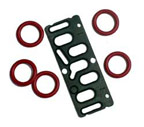
|
7108
S. Alton Way, Unit I |
(303) 758-2728
Home > Elastomer Properties > Shear Modulus and More
Elastomer Properties - Shear Modulus/Tear Strength/Dynamic Stress-Strain
Shear Modulus: The shear modulus is an important property in design calculations for elastomers used in shear. The test methods typically require that the test sample be bonded to metal plates. The resulting ratio of the shear stress to shear strain is the shear modulus.
Test Methods:
-
ISO 1827
Tear Strength: For considerations of removing a molded part from the production mold, or for determining the ease of which a tear can start and propagate in application, tear strength is an important property. Different test methods use different shapes and methods for applying a tearing force.
Test Methods:
-
ISO 34, 816
-
ASTM D624
Dynamic Stress-Strain: In cyclic or dynamic applications, the viscoelastic properties of elastomers are very important. Lost energy, in the form of heat, arises from molecular friction as a result of an applied load. The percentage energy loss per cycle is known as “hysteresis.” When the loading and unloading cycle continues, the shape and position of the hysteresis curve changes.
The response of a specimen to a sinusoidal deformation can best exhibit the dynamic properties of an elastomer. The elastic component of the elastomer is responsible for the in-phase stress, while the viscous component is responsible for the out-of phase stress. The amount by which the strain response lags the resultant of the two stresses (in-phase and out-of-phase) is known as the phase or loss angle, ð. The more viscous an elastomer, the greater the phase or loss angle. The tangent of this angle “tan ð,” in the simplest terms, is the ratio of the viscous modulus to the elastic modulus.
Dynamic Properties for Various Sealing Elastomers
| PROPERTY | AEGIS | Fluoroelastomer | EPDM | Nitrile | Silicone | Fluorosilicone |
| Tensile Strength | GOOD | EXCELLENT | EXCELLENT | EXCELLENT | FAIR | FAIR |
| Abrasion Resistance | FAIR | GOOD | GOOD | GOOD | POOR | POOR |
| Tear Resistance | FAIR | FAIR | EXCELLENT | EXCELLENT | POOR | POOR |
Next topic Elastomer Properties - Abrasion/Coefficient of Friction/Electrical Properties
We are located in the Denver Technological
Center in a suburb of Denver, Colorado
©1997-2017, Problem Solving Products, Inc.
Website Map | Privacy Statement
| Terms of Use

